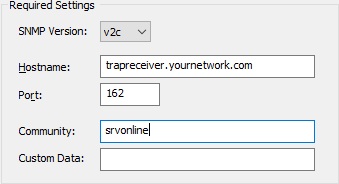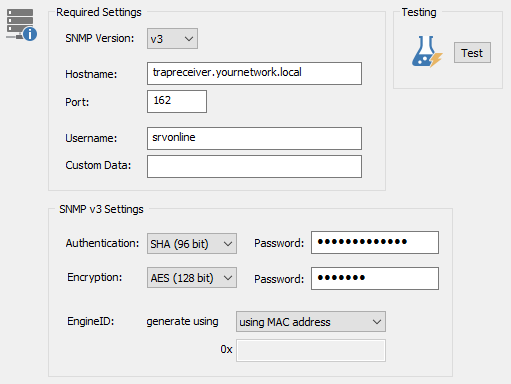You can send v1, v2c or v3 SNMP traps to a SNMP management station.
MIB
In order for traps to be displayed correctly in your SNMP management system, you will need to import/compile one of the two MIBs that are shipped with EventSentry:
•EventSentryV1.mib
•EventSentryV2cV3.mib
These files are installed in the "Mibs" sub directory of the installation directory of EventSentry (C:\Program Files\EventSentry\Mibs by default). Depending on the version of trap you are sending, you will need to import either one:
Version 1: EventSentryV1.mib
Version 2c & 3: EventSentryV2cV3.mib
Common Settings
|
SNMP Version The version with which the SNMP trap will be sent.
Hostname The host name or IP address of the machine running the SNMP management application.
Port The UDP port to be used, 162 by default.
Test Sends a test trap to the configured management station. |
SNMP v1/v2c Settings
Community
The SNMP community string.
SNMP v3 Settings
If the receiving management station supports v3 SNMP traps, then you configure some of the advanced SNMP options, such as authentication and encryption, that are only available in SNMP v3 traps.
|
Authentication (Data Integrity) Select one of the available authentication mechanisms (MD5 (96bit) or SHA (96bit)) or select "None" if no authentication/data integrity is desired. A password must be entered when authentication is selected.
Encryption (Privacy) Select one of the available encryption algorithms (DES, 3DES or AES (128 bit)) or select "None" if no encryption is desired. A password must be entered when encryption is selected.
EngineID SNMPv3 requires an engineID, which is a unique identifier for a SNMP engine (such as EventSentry). EventSentry can either generate the engine ID automatically, using either the MAC or IP address of a network interface, or you can manually specify the engine ID. On multi-homed hosts, the MAC or IP address of the interface sending the trap is used when the engine ID is automatically generated.
|

